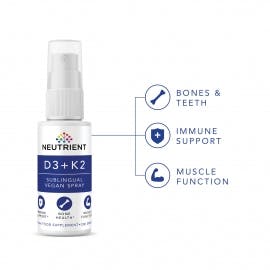The Surprising Truth About Vitamin D: It’s Not Just for Winter
Vitamin D is often dubbed the “sunshine vitamin,” but this commonly used term only tells half the story. While it’s true that our bodies can make vitamin D when exposed to sunlight, many people are surprised to learn that this nutrient isn’t technically a vitamin at all — it’s a prohormone, with a chemical structure that is almost identical to cholesterol. What’s more, it plays a far more complex and influential role in the body than most other vitamins.
Despite longer days and brighter skies in summertime, some people still struggle to maintain optimal vitamin D levels during the sunnier months. And for others, year-round supplementation may be the only way to support their body’s needs consistently.
What Are the Benefits of Vitamin D? Key Roles in Bone, Muscle, and Immune Health
Vitamin D is a nutrient that is widely studied and shown to contribute to multiple physiological functions, including the maintenance of bones and teeth, and normal muscle and immune function. It also plays an important role in cell division and helps the body absorb calcium and phosphorus.
Once activated by the liver and kidneys, vitamin D behaves more like a hormone than a traditional nutrient. Circulating vitamin D is affected by a complex network of feedback mechanisms that require multiple receptors and enzymes, indicating that vitamin D is regulated more like a steroid than a nutrient. It interacts with receptors found throughout the body, including in the brain, bones, muscles, and immune cells. This widespread distribution suggests that its influence may be more far-reaching than was once thought.
Researchers are increasingly exploring vitamin D’s potential roles beyond bone and immune health, including its potential involvement in mood regulation and cardiovascular health. 1 Vitamin D has been shown to have multifaceted functions across various biological pathways, underscoring the importance of maintaining adequate levels throughout the year to support overall health.2
Who Needs Vitamin D Supplements Year-Round? Risk Factors You Should Know
It’s a common misconception that just because the sun is out, we’re all getting enough vitamin D. But the truth is more nuanced. A variety of factors can affect how well your body makes and uses vitamin D, including:
- Skin tone: People with darker skin have more melanin, which reduces the skin’s ability to produce vitamin D from sunlight.
- Age: As we get older, the skin becomes less efficient at synthesising vitamin D.
- Geography and lifestyle: Living in northern latitudes, spending lots of time indoors, using sunscreen, or covering up for cultural or personal reasons can all reduce sun exposure, even in summer.
- Digestive health and body weight: Absorption of vitamin D from food or supplements can be impaired in individuals with certain gastrointestinal conditions. Body composition may also influence vitamin D status, with some studies suggesting it may be trapped in fat tissue, making it less available for the body.
Vitamin D Deficiency: Why It’s More Common Than You Think
Vitamin D deficiency is a common issue worldwide. According to data from the UK’s National Diet and Nutrition Survey, approximately one in six adults and one in five children have levels considered too low for long-term health. 3 The risk increases in winter months, but for some groups, low levels persist even during summer.
Public health authorities in several countries, including the UK, recommend that everyone consider taking a daily supplement during autumn and winter. But for those with increased needs or limited sun exposure, year-round supplementation may be beneficial.
Beyond Sunlight: Lifestyle and Genetics Impacting Your Vitamin D Levels
Although sunlight plays a major role in vitamin D production, its effects go well beyond seasonal patterns. Some individuals report feeling their best only when their vitamin D levels are within a certain range, even during summer. While more research is needed to understand all the individual differences, emerging studies suggest that genetics, lifestyle, and underlying health conditions may all influence how our bodies use and respond to vitamin D.
According to a 2021 review in the journal Nutrients, vitamin D needs can vary from person to person, suggesting that a one-size-fits-all all approach to supplementation may not be ideal.4 The researchers recommended a more personalised approach, allowing for an individual’s lifestyle and health factors to help them get the most benefit from vitamin D.

How to Bolster Your Vitamin D Levels Effectively
If you suspect you may be low in vitamin D, even during summer, consider the following:
- Get tested: A 25(OH)D blood test can reveal your vitamin D status.
- Talk to a professional: A qualified health practitioner can help you decide on an appropriate dosage.
- Choose the right form: Vitamin D3 (cholecalciferol) is generally the preferred form for supplementation. Several studies have shown that vitamin D3 is significantly more effective than vitamin D2 at raising and maintaining blood levels.5
- Support with food: While it’s difficult to get enough vitamin D from food alone, oily fish, eggs, fortified foods, and mushrooms exposed to sunlight can help contribute to your intake.
- Maintain regular exercise in the winter: A recent trial has found that regular exercise helps to prevent the usual seasonal decline in vitamin D.6
Best Practices for Taking Vitamin D: Dosage, Forms, and Pairing with K2
Consider your skin tone, lifestyle and health status to make sure your vitamin D needs are being met. You may need a little extra help to keep your levels topped up year-round. Studies show that at least 1,000–2,000 IU/day of vitamin D3 is typically needed to raise low blood levels, depending on the severity of deficiency, body weight, and sun exposure. Additionally, always pair vitamin D with vitamin K2 for optimal absorption and calcium balance.
Written by: Jacqueline Newson BSc(Hons) Nutritional Therapy
References
Grant WB, Wimalawansa SJ, Pludowski P, Cheng RZ. Vitamin D: Evidence-Based Health Benefits and Recommendations for Population Guidelines. Nutrients. 2025 Jan 14;17(2):277. doi: 10.3390/nu17020277. PMID: 39861407; PMCID: PMC11767646.
Di Rosa, M., Malaguarnera, M., Nicoletti, F., & Malaguarnera, L. (2021). Vitamin D: Not Just Bone Metabolism but a Key Player in Cardiovascular and Metabolic Diseases. Nutrients, 13(2), 429.
National Diet and Nutrition Society. https://assets.publishing.service.gov.uk/media/5fd23324e90e07662b09d91a/NDNS_UK_Y9-11_report.pdf?utm_source=chatgpt.com.[accessed 20.05.25].
Ramasamy I. Vitamin D Metabolism and Guidelines for Vitamin D Supplementation. Clin Biochem Rev. 2020 Dec;41(3):103-126. doi: 10.33176/AACB-20-00006. PMID: 33343045; PMCID: PMC7731935.
Tripkovic L, Lambert H, Hart K, Smith CP, Bucca G, Penson S, Chope G, Hyppönen E, Berry J, Vieth R, Lanham-New S. Comparison of vitamin D2 and vitamin D3 supplementation in raising serum 25-hydroxyvitamin D status: a systematic review and meta-analysis. Am J Clin Nutr. 2012 Jun;95(6):1357-64. doi: 10.3945/ajcn.111.031070. Epub 2012 May 2. PMID: 22552031; PMCID: PMC3349454.
Perkin OJ, et al. Exercise without Weight Loss Prevents Seasonal Decline in Vitamin D Metabolites: The VitaDEx Randomized Controlled Trial. Adv Sci (Weinh). 2025 May 11:e2416312. doi: 10.1002/advs.202416312. Epub ahead of print. PMID: 40349161.






